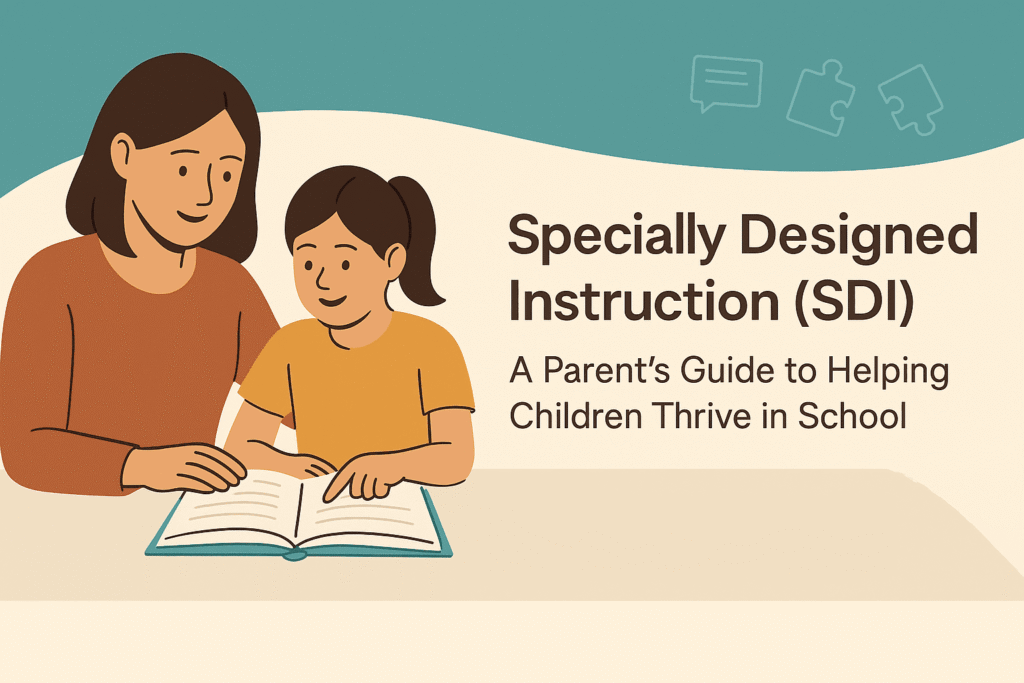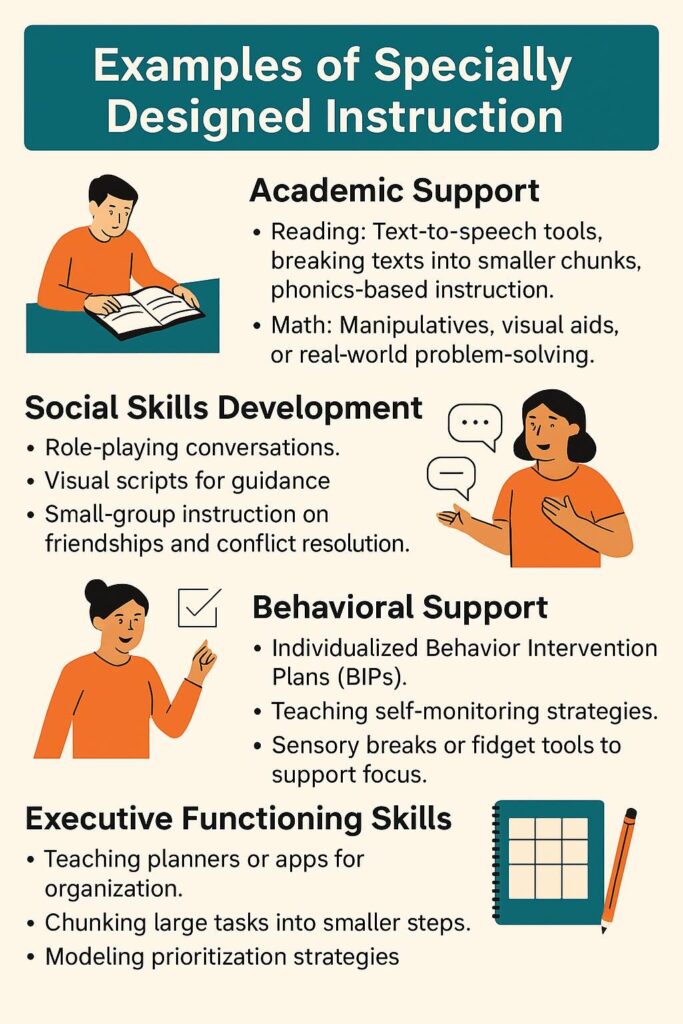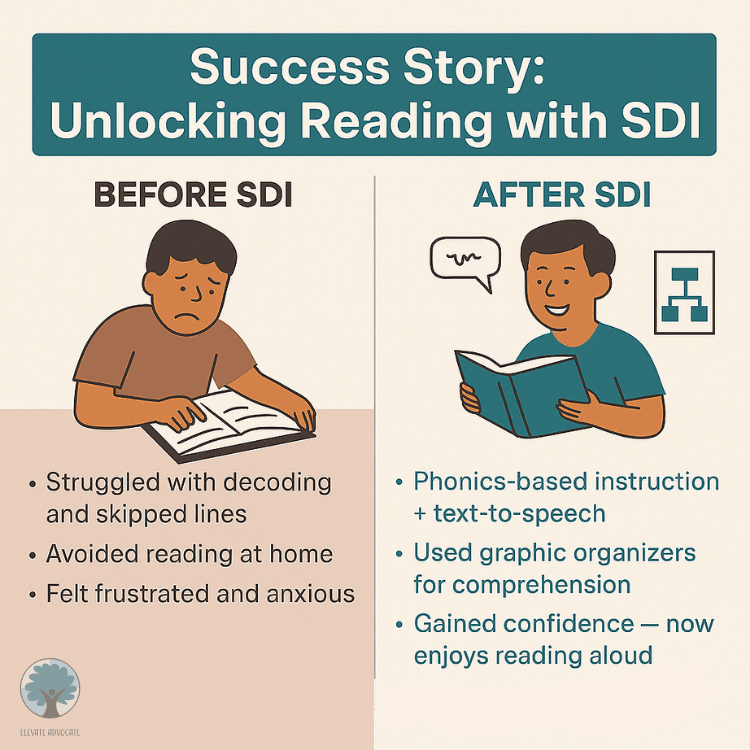
TL;DR: Specially Designed Instruction (SDI) means adapting how teaching is delivered so students with disabilities can access and make progress in the general curriculum. It covers academics, social skills, behavior, and executive functioning. SDI works best when families and schools collaborate closely.
What Is Specially Designed Instruction (SDI)?
Specially Designed Instruction (SDI) is individualized teaching that adapts content, methods, or instructional delivery so students with disabilities can achieve their Individualized Education Program (IEP) goals.
Unlike accommodations (which change how students learn) or modifications (which change what is expected), SDI changes the instruction itself.
Key qualities of SDI:
Individualized: Linked directly to your child’s IEP goals.
Flexible: Adjusted as needs change.
Purposeful: Removes barriers to measurable progress.
Learn how IDEA defines special education (U.S. Department of Education).

Why a Whole-Child Approach Matters
Specially Designed Instruction is most effective when it’s not treated as a stand-alone strategy, but as part of a whole-child approach. This means looking beyond academics to consider a student’s social, emotional, and physical needs — and weaving together the right blend of SDI, accommodations, and specialized supports.
When teachers, specialists (such as occupational or speech therapists), parents, and advocates work in partnership, each brings a unique perspective:
Parents share insights about what motivates and comforts their child at home.
Teachers identify which instructional strategies are effective in the classroom.
Specialists provide targeted expertise, whether it’s improving fine motor skills, building communication strategies, or supporting sensory needs.
Advocates act as the quarterback, helping to coordinate resources, align efforts, and ensure the entire team stays focused on serving the child’s best interests.
Together, this collaborative team creates a personalized plan that addresses the whole child, aligning supports across settings. The result is more than progress on paper — it’s real growth in confidence, independence, and the ability to thrive both in and out of school.

Before SDI:
“Ethan,” a 3rd grader, dreaded reading time. When asked to read aloud, he stumbled over multi-syllable words, skipped entire lines of text, and often gave up halfway through a passage. At home, his parents noticed he avoided books altogether and grew frustrated when homework involved reading. Despite being bright and curious, Ethan’s inability to decode grade-level text left him feeling defeated and anxious.
Challenges:
Difficulty sounding out longer words.
Trouble tracking text across lines.
Limited comprehension because so much energy went into decoding.
Low confidence, leading to avoidance behaviors.
After SDI:
With the help of Specially Designed Instruction, Ethan’s IEP team created a targeted plan. His special education teacher introduced a multi sensory phonics-based reading program, taught in small groups four times a week. To support comprehension, Ethan used text-to-speech technology and received graphic organizers to break down stories into characters, setting, and main ideas. His parents collaborated by practicing the same decoding strategies at home during short, low-pressure reading sessions.
Instructional Supports:
Explicit phonics instruction with daily practice.
Text-to-speech to reduce decoding fatigue.
Graphic organizers to scaffold comprehension.
Positive reinforcement for small milestones.
Outcome:
Within three months, Ethan’s reading fluency improved noticeably. He was able to read short chapter books with 90% accuracy, and he began raising his hand to volunteer during group reading activities. Most importantly, Ethan rediscovered his love of stories. His confidence carried over into other subjects, and his parents reported a dramatic change: instead of avoiding books, he now asked to read bedtime stories aloud.
Ready to Take the Next Step?
Understanding Specially Designed Instruction is the first step toward ensuring your child receives the support they need to thrive. But you don’t have to navigate this journey alone. At Elevate Advocate, we partner with families to turn overwhelming IEP processes into clear, confident action plans.
If you’re wondering how SDI could look in your child’s classroom—or if you want help making sure their IEP truly meets their needs—we’d love to connect with you.
Schedule your free 15-minute consultation today. Together, we’ll review your child’s unique situation, answer your questions, and map out the next steps to advocate effectively for their success.
Frequently Asked Questions
No. Accommodations change how a child learns. Modifications change what they are expected to learn. SDI changes instruction itself to meet IEP goals.
Special educators and related service providers. General educators may also deliver SDI with support, depending on the IEP.
It appears in the services section, tied to specific goals. It should include frequency, setting, and who provides the instruction.
Ask in writing for an IEP meeting or evaluation. Share examples of what works at home.
Through data—work samples, rubrics, progress monitoring—that show measurable growth.
